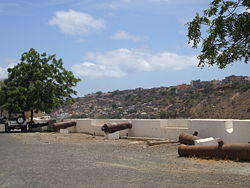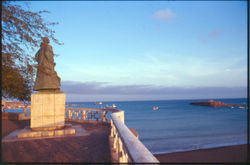Praia
2008/9 Schools Wikipedia Selection. Related subjects: Africa; Cities
Praia (pronunciation in IPA: /'pɾajɐ/; meaning “beach” in both Portuguese and Cape Verdean Creole) with a population of about 90,000, is the capital of Cape Verde, an island nation in the Atlantic Ocean west of Senegal. It lies on Santiago island in the Sotavento group. It is the island's ferry port and is home to one of the nation’s three international airports. The city centre is known as Plateau due to its location on a small plateau. Praia is located at 14°55' North, 23°31' West (14.91667, -23.51667).
Praia is Cape Verde’s largest city, and a commercial centre and a port that ships coffee, sugar cane, and tropical fruits. Praia also has a fishing industry. There are resort beaches nearby. It is also the seat of the municipality bearing the same name.
History
The town of Praia de Santa Maria appeared in 1615 when it took place the settlement of a plateau nearby a beach (Santa Maria beach) that offered good conditions for ships. Initially used as a clandestine harbour (in order not to be paid the customs fees at the then capital Ribeira Grande) the settlement gradually acquired the characteristics of a town with the growing fleeing of the population from Ribeira Grande, during the decline of the latter. The official passage of the capital city from Ribeira Grande to Praia took place in 1770.
In the history of Cape Verde there have been successive proposals for transferring the capital from Praia to somewhere else, the last one being the proposal of moving to Mindelo, in the late 19th century. The successive Portuguese administrations never showed an interest (economical or political?) in moving the capital of Cape Verde. Through an official decree in 1858, when the status was changed from town to city, Praia has definitely remained the capital of Cape Verde, concentrating political, religious and economic roles.
During the Portuguese administration, only the central plateau was considered to be the main city, worthy of being urbanized and concentrating the services. Only after the independence that the reality was finally accepted that Praia already included the surrounding neighborhoods. After the independence the city suffered a demographic boom, and in 30 years its population quadrupled, receiving migrating movements from all the islands and contributing for the whole island of Santiago reaching half the population of Cape Verde, the Municipality of Praia a fourth, and the city of Praia a fifth.
Geography
Geographically, Praia may be described as a set of plateaus and their surrounding valleys. These plateaus have generally the name of achada (Achada de Santo António, Achada de São Filipe, Achada Eugénio Lima, Achada Grande, Achadinha, etc. — being achada a Portuguese word to designate a volcanic plateau), but the central one is colloquially called Plateau (in Portuguese itself). The urban settlement is made mostly on top of these plateaus and along the valleys. The islet of Santa Maria is in front of the beach bearing the same name (today more known as Gamboa).
For a long time, only the Plateau was considered to be the city, being the other neighborhoods relegated to the condition of peripheral suburbs, in spite of always having a close relationship with the Plateau (people movements, goods and services exchanges, etc.). That’s why for a long time only the Plateau had good urbanization with its own infra-structures. The remaining neighborhoods developed in a bit organic, chaotic way.
Only after the independence that the Plateau altogether with the other neighborhoods were considered making up the entire Praia city. The whole city was then equipped with adequate infra-structures, and some de-centralization was aimed. In spite of being recent, the urbanistic plans are already in course and the city is expanding North, through Achada de São Filipe, and West through Palmarejo. Even though the Plateau is still attracting the daily movements within the city, not because it is the biggest neighborhood (that would be Achada Grande) neither because it is the most populated (that would be Achada de Santo António), but because it is still considered as the economic and working centre of the city. In spite of de-centralization attempts, the population continues to consider the neighborhoods peripherals to the Plateau as dormitory zones or industrial zones.
Economy
The economy of Praia is dependent above all on the services sector, with some industry as well.
Some industries exist, located on the coast (the fishing industry) or outlying neighborhoods (transformation industries of agricultural products, industries of material for civil construction, etc.)
However, the principal economic activities of Praia belong to the tertiary sector. Beyond activities related to administration and governance (local and national), there is extensive commerce, services (health care, education, tourism, restaurants and hotels, public functions, etc.) and other activities of a liberal character.
With regard to transport, Praia has a network of urban public transport, a seaport and an airport. The port of Praia is the principal port of exit of products for the island, and the principal port of entry. The airport, with domestic and international destinations, was recently enlarged to allow for long-haul flights.
Culture
In cultural terms, the city of Praia is a notable contrast to the rest of the island of Santiago. While the rest of the island, having been first to be inhabited, maintains conservative and traditionalist characteristics, Praia, being the capital city, possesses a more cosmopolitan outlook. In culture, Praia has easily absorbed influences from the outer islands, due to inter-island migration, as well as influences from abroad due to the concentration of population of foreign origin and the relative easiness of communication with other nations. It is easier to find “authentic” cultural elements of Santiago the further one goes from Praia.
Precisely because it is the capital, and for having communications facilities with the world and the greatest concentration of diverse people, Praia is one of the best places in Cape Verde for cultural experiences. Cultural activities that occur occasionally include openings of works, expositions, and shows. To support these there is an infrastructure that includes various show halls, the Palace of Culture, the Ethnographic Museum and the National Historical Archive. Praia also enjoys a diverse array of options for night entertainment.
Education
The city of Praia is home to the first primary school in the archipelago, originally known as the Escola Central (today known as the Escola Grande). For much time it was the only primary school in Praia. At the beginning of the 1960s, other primary schools began to be built, in neighborhoods around the Plateau and in other localities on the island.
Praia was also the first site in Cape Verde with an institution of secondary education, with the birth of the Liceu Nacional in 1861. However, the Portuguese authorities were not interested in implementing secondary education in Cape Verde, and the school failed due to these difficulties; secondary education became, afterwards, the role of the Seminário de Ribeira Brava, and later of the lyceum in Mindelo. Only in 1960 did Praia again have secondary education, first in the building in front of September 12 Plaza, and later in its own building. With the expansion of education in Cape Verde in the 1990s, various buildings dedicated to education were constructed in Cape Verde, and Praia currently has 7 secondary education schools.
For higher education, there is the Instituto Superior de Educação and the Instituto Piaget.
Sporting teams
Arenas
- Estádio da Varzea - where Sporting, Boavista and Travadores play
Basketball
- ABC - Serie A
- Prédio - Serie A
- Sporting - Serie A
Football/soccer'
- Académica - Serie A
- Boavista - Serie A
- Praia Rural - Serie B
- Sporting Clube da Praia - Serie A
- Tchadense - Serie B
- CD Travadores - Serie A
Communications
- Praia FM - Radio Station
- Rádio Praia or Rádio Clube de Cabo Verde - Cape Verde's first radio station first operated in 1945 by Fernando Quejas
- RTC - national/state station of Cape Verde
- Capeverdean Television station
Transportation
The city is served by Praia International Airport and TACV Cabo Verde Airlines.
Main sights
Landmarks includes Albuquerque Square, the old city hall, the Presidential Palace, constructed in the end of the 19th century used to be housed for the Portuguese governor and Museu Etnográfico (Ethnographic Museum) and Monumento de Diogo Gomes, named after the Portuguese navigator who founded the island of Santiago 1460
Other
Praia has schools or collegiates (colegio), lyceums (middle schools), gymnasia (secondary schools), churches, beaches, ports, universities ( Jean Piaget and Uni-CV) , a post office and squares ( praças).
People
Nani, a footballer who currently plays for English giants, Manchester United and Portugal.


